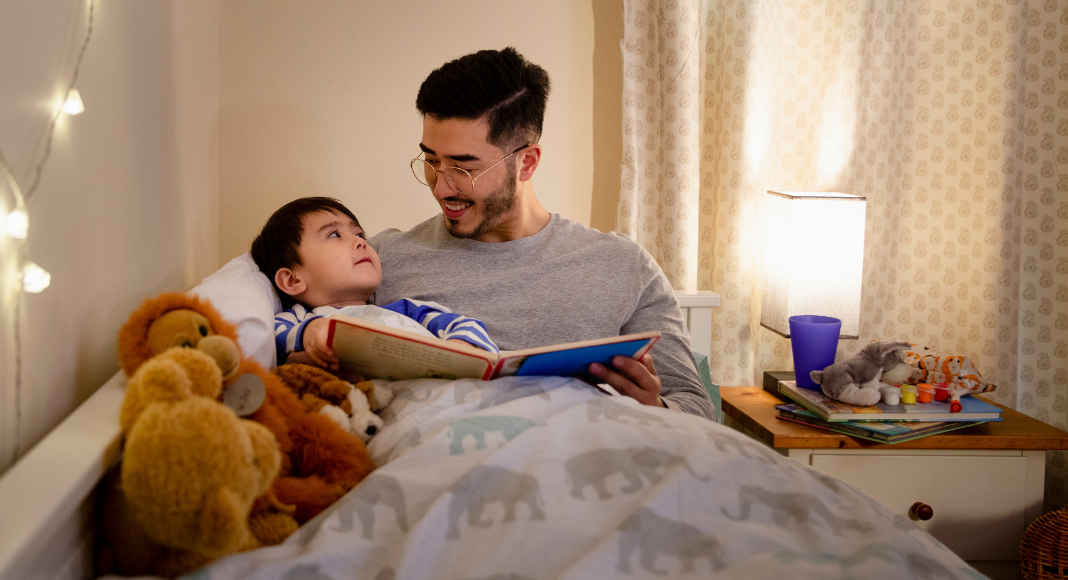 We all know that a consistent bedtime routine helps children transition from being awake to falling asleep, but it isn’t always that easy.
We all know that a consistent bedtime routine helps children transition from being awake to falling asleep, but it isn’t always that easy.
Think of bedtime as a two-step process. Parents often get confused about how long their child’s bedtime routine should be and what activities should or shouldn’t be included. If you’re unclear, it may help to view bedtime as a two-step process. Step one provides time for winding down, and step two is the actual bedtime routine.
1. Start with winding down.
Relaxing, calming activities that occur the last hour or two before bedtime should be considered part of the winding down process. Think of these activities as part of the evening routine, not the actual bedtime routine. Although predictability is always a good thing, these activities don’t need to be set in stone or happen in the same order every night. They need to create a basic structure for ending the child’s day.
For example, dinner, quiet playtime, and a bath may be the basic components of a typical nightly wind down, but skipping a bath because of an unexpected phone call or going out for an ice cream cone after dinner is perfectly okay. It’s wise to avoid activities that may rev your child up during the last hour or two before bedtime. A wrestling match with daddy right before story time is rarely a good idea.
Quiet, more peaceful activities will be much more helpful in preparing your child for sleep. It’s especially important to avoid screen time for the final thirty to sixty minutes before bedtime – numerous studies suggest that the light emitted from computers, iPads, iPhones, Kindle, and televisions can halt the body’s melatonin production. This hormone helps us feel drowsy and fall asleep.
2. Then start the bedtime routine.
Your child’s actual bedtime routine should consist of a predictable series of steps immediately preceding bedtime every night. These steps, when repeated in the same order every night, will help to cue their body and their mind that it’s time to sleep.
The steps in the routine should be tailored to your child’s age and temperament. For example, an infant’s bedtime routine may be as simple as putting on a sleep sack, turning on the white noise machine, and singing a lullaby. A toddler’s routine may include brushing teeth, a potty visit, three books, saying goodnight to the stuffed animals, and assisting mom with turning off the lights.
Routines shouldn’t be overly complicated or lengthy – 15 minutes for a baby and 30 minutes for a toddler is a good place to start. Be clear about the order of the routine and be as consistent as possible every night. If your toddler is constantly dragging out the routine (as they tend to do!), my article about ending bedtime battles has suggestions on how to keep things on track. And, of course, if your child hasn’t learned to fall asleep without assistance and is creating challenges at bedtime, implementing a solid sleep coaching plan to teach them how to fall asleep on their own can make bedtime a much happier time for the entire family.
Ultimately, the key to an effective bedtime routine isn’t as much about what you do but how you do it. (Mommy needs a bedtime routine too). Create a plan, stick to it, and start early. Even newborns can benefit from a simple nightly routine.
If you have more than one child and are struggling with managing two or maybe even three or four bedtime routines at once, there will probably need to be some compromising. Maybe your older child can entertain themselves in their room while you put your younger child to bed first, or you can develop a joint bedtime routine that includes everyone reading together in one sibling’s room before heading off to their beds for a tuck-in.
Try not to rush your children through their routines – saying goodnight means separating from you, which can be challenging for some children. Focused attention for those last 15 to 30 minutes before bedtime will help you reconnect after a busy day and go a long way to ease the mental and physical transition for your child.


























